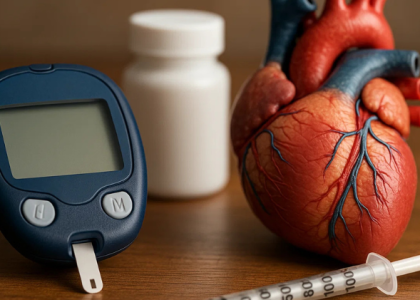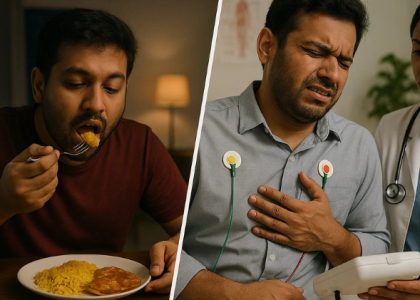“I’m just tired. Don’t worry about me.” That’s what my dad kept saying for months whenever we asked why he wasn’t joining our family walks anymore. But the truth was more serious: he was living with heart failure — and none of us knew.
By the time we convinced him to see a doctor, his heart was working at less than half its normal strength. The doctor told us that with earlier treatment, he could have felt much better, much sooner.
Our story isn’t unusual. Across South Asian communities, many fathers, uncles, and grandfathers brush off symptoms that could signal heart problems. They say they’re “just getting old” or “working too hard” — when their bodies are actually sending warning signals we all need to recognize.
When Tiredness Isn’t Just Aging
Heart failure sounds scary, but it doesn’t mean the heart has “failed” or stopped. It means the heart muscle has weakened and can’t pump blood as effectively as it should.
This isn’t about your dad being “lazy” or simply “getting older.” His body is working harder than ever, actually. Think of it this way: his heart is like a water pump that’s worn out. It’s still working, but it takes more effort to move the same amount of water through the garden hose.
According to the Cleveland Clinic, heart failure often develops slowly, over months or years. The heart muscle gradually weakens, and the body tries to compensate by:
- Making the heart beat faster
- Holding onto water (causing swelling)
- Redirecting blood to vital organs (and away from less important areas)
This explains why a person might feel tired all the time — their body is constantly working overtime, even at rest.
Common Symptoms That Families Miss
Your father might not tell you he’s struggling, but his body probably is showing signs. Here are key symptoms to watch for:
- Always tired, even after sleeping well
- Short of breath when doing simple activities (like climbing stairs or walking to the car)
- Swollen feet, ankles or belly (shoes might feel tight)
- Needs extra pillows to sleep or trouble lying flat in bed
- Frequent coughing or wheezing, especially when lying down
- Sudden weight gain (from water retention) or loss of appetite
- Confusion or forgetfulness that wasn’t there before
Important tip: He may not complain — but watch what he avoids. Has he stopped going for walks? Does he take rest breaks during activities he used to do easily? Does he sit down to put on his shoes now?
The Mayo Clinic notes that many of these symptoms develop so gradually that people adjust to them without realizing something’s wrong. This is where family members can play a crucial role in noticing changes.
Why South Asian Men Are at Risk
Research from the American Heart Association shows that South Asians have a significantly higher risk of heart disease, and it often strikes 10 years earlier than in other populations.
Several factors make our fathers especially vulnerable:
- Health factors: Higher rates of diabetes, high blood pressure, and abdominal fat (even in men who aren’t visibly overweight)
- Cultural factors: Less likely to discuss symptoms or “complain” about health issues
- Traditional masculine norms: The expectation that men should “push through” discomfort
- Limited awareness: Many don’t know that extreme fatigue can be a heart symptom
- Work priorities: Putting family obligations before personal health needs
The Journal of the American College of Cardiology reported that South Asians living in America have a four times higher rate of heart disease compared to the general population. Studies from the Indian Council of Medical Research show similar elevated risks in South Asia itself.
What You Can Do as a Son or Daughter
If you’re worried about your father, here are practical steps you can take:
Start the conversation gently
- Instead of saying “You look sick,” try: “How’s your breathing these days, Dad?”
- Frame it as a family concern: “We want you around for a long time”
- Share this article on family WhatsApp or during your next visit
Help with healthcare
- Offer to schedule a heart checkup and go with him
- Request specific tests: ECG, echocardiogram, and blood work (BNP test)
- Take notes during appointments (doctors appreciate an engaged family)
- Help organize medications if needed
Watch for resistance
- If he says, “Don’t waste money on me,” remind him how valuable he is to the family
- If he’s worried about missing work, help find a weekend appointment
- If he’s embarrassed about being examined, find a South Asian doctor if possible
Support healthy habits
- Suggest walking together after dinner (start with just 5-10 minutes)
- Help prepare heart-healthy versions of favorite foods
- Ensure he takes any prescribed medications regularly
The World Health Organization emphasizes that family support dramatically improves outcomes for heart patients. Your involvement matters more than you know.
A Call for Awareness in Our Communities
Heart failure is not a death sentence. With proper treatment, many people live active, full lives for many years. The key is early detection and consistent care.
Here’s how you can spread awareness:
- Share this article with siblings, cousins, and friends who have aging parents
- Print the symptom list above and keep it on your refrigerator
- Talk openly about health in your family gatherings
- Encourage the men in your life to get regular checkups — even when they feel fine
Remember, in our culture, it’s often considered improper to “interfere” with our elders. But when it comes to health, sometimes loving intervention is the greatest form of respect we can show.
Catching heart problems early can give your father more years — and more strength to enjoy them. The son or daughter who insists on a checkup today might be giving the greatest gift possible: more time together as a family.
This article includes information from the American Heart Association, Journal of the American College of Cardiology, Mayo Clinic, Cleveland Clinic, World Health Organization, and the Indian Council of Medical Research.




